IDEX Online Research: Jewelry Stocks Slump in Second Quarter
July 19, 06
Jewelry stocks have historically been more volatile than the overall stock market, and they continued that tradition in the second calendar quarter of 2006. While the total market was down just under 2 percent, as measured by the broad market S&P 500, the IDEX Online Portfolio of Jewelry Stocks was down nearly 11 percent. The IDEX Online Portfolio consists of 13 global jewelry industry stocks, including internet merchants, retailers, and suppliers. The index is based on buying an equal number of shares of each company.
Every category of jewelry stocks – internet merchants, retailers, and suppliers – suffered from the market’s downdraft. The graph below summarizes stock market performance as well as jewelry stock performance for the second quarter.
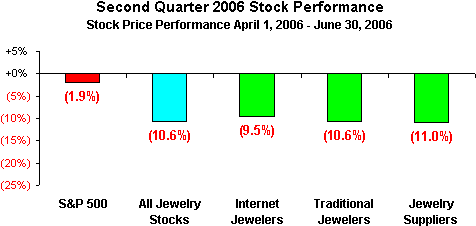
Source: Stock Markets
Investor Uncertainty Hurt
While tangible signs of economic growth remained strong, investor uncertainty topped the list of reasons that stocks posted poor performance in the second quarter. On the positive side of the ledger, both the
But investors often worry about what is around the next corner or just over the hill, especially when the economy appears to be peaking, and that was the case in the second quarter. Investors are worried that global economic growth may start to slow early in 2007. Investors are worried about the current inflationary pressures. Investors are worried about geopolitical issues. In traditional fashion, this wall of worry caused investors to over-react and sent stocks plummeting in the quarter.
Among jewelry stocks, investors continue to be worried about the consumer’s ability to fund discretionary purchases such as jewelry, especially as higher gasoline prices eat into shoppers’ budgets. We have already seen some fall-off in spending for dining outside of the home, beer, and some other discretionary categories. Jewelry sales had been strong in the first quarter, but showed signs of slumping as the second quarter rolled around.
Year-to-Date Stock Performance Disappointing
Both the market and jewelry stocks in the IDEX Online Portfolio posted advances in the first quarter of the year. In the second quarter, they gave back all of those gains and more. For the six months year-to-date,
The graph below summarizes stock performance from the broad market as well as jewelry stocks for the six months ended June 30, 2006.
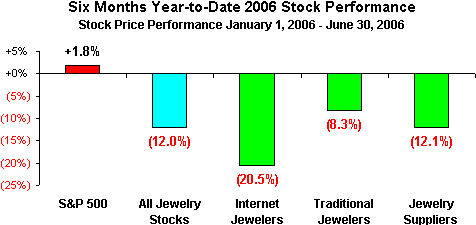
Source: Stock Markets
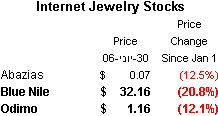 Bold = Included in index |
Internet Stocks Plummeted in First Six Months
Of the three internet jewelry stocks; only two –
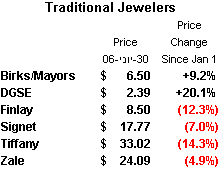 Bold = Included in index |
Jewelry Retail Stocks Weak
Of the six retail stocks included in the IDEX Online Portfolio – Birks/Mayors, Finlay, Signet, Tiffany, and Zale – only two have risen in price from the beginning of the year: Birks/Mayors and DGSE. The others – all well-established names in the industry – are down.
In the case of DGSE, investors may be seeking a “gold play.” Gold bullion sales have surged to 40 percent of DGSE’s total revenues, up from about 20 percent three years ago. As DGSE sells low-priced gold from its inventory, its profits should be quite strong. In fact, profits from bullion sales in the first quarter were up six-fold from the prior year. Birks/Mayors is still somewhat of a mystery to investors. As financial disclosures from this merged operation unfold, investors will have a better understanding of the company. In the meantime, investors are probably betting that efficiencies of scale should boost overall profits.
The four established retail jewelers in the IDEX Online Portfolio all suffered the same fate: their stock price has fallen for the year-to-date. Besides investor worries about consumer discretionary spending, each company appears to have its own problems. Finlay continues to lose leased departments. Signet’s
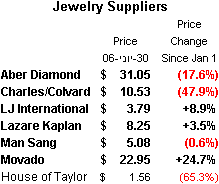 Bold = Included in index |
Stocks of jewelry suppliers also took a hit as investors fled them over the past six months. Charles & Colvard was by far the biggest casualty as sales gains have evaporated – a trend that could continue near term. Investors did not like the sales erosion in the first quarter – down nearly 30 percent from the prior year. As a result, they have fled CTHR shares, pushing the price down to about $10. At their peak in 2005, CTHR shares were selling for over $26 per share.
The performance of the balance of the jewelry supplier stocks were a mixed bag: some were up and some were down. Movado seems to be doing everything right: each of its brands has a solid strategy (though sales of its luxury
Aber Diamond continues to report good news, but competitive worries have ensnared investors. Man Sang shares are sitting in a trading range. House of Taylor is another company that should not be public in the current regulatory and investing environment, in our opinion.
Global Luxury Stocks Flat
As a comparison, IDEX Online maintains an index of ten global luxury stocks, including Burberry, Coach, LVMH, and others. For the first six months of 2006, this group of stocks posted essentially flat performance, as the graph below illustrates.
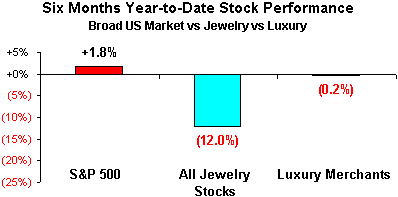
Source: Stock Markets
Outlook for Jewelers: Uncertain
Not only are investors uncertain, but jewelers and diamantaires are uncertain. The recent JCK Las Vegas market generated “mixed” results for most suppliers. This means that they were disappointed with their orders.
It is important to remember the old adage that Wall Street often points to: “the stock market has predicted twelve of the past six recessions.” In short, the stock market is a very poor forecaster of economic recessions; you can get the same odds by flipping a coin. However, we note that it is a relatively good predictor of economic upswings.
Unless it is clear that both the